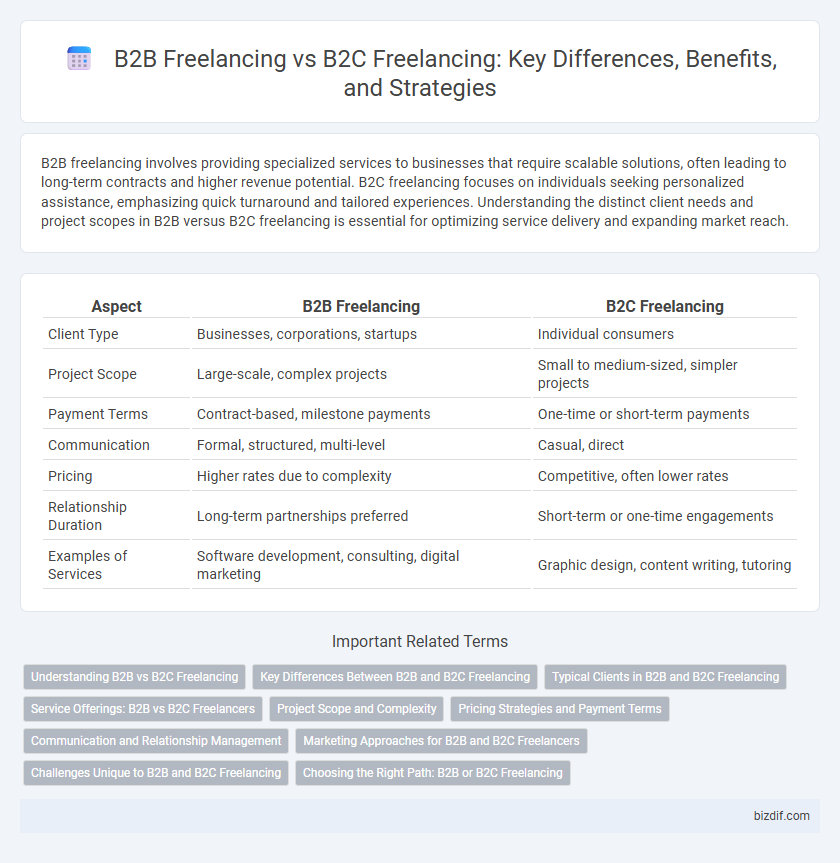B2B freelancing involves providing specialized services to businesses that require scalable solutions, often leading to long-term contracts and higher revenue potential. B2C freelancing focuses on individuals seeking personalized assistance, emphasizing quick turnaround and tailored experiences. Understanding the distinct client needs and project scopes in B2B versus B2C freelancing is essential for optimizing service delivery and expanding market reach.
Table of Comparison
| Aspect | B2B Freelancing | B2C Freelancing |
|---|---|---|
| Client Type | Businesses, corporations, startups | Individual consumers |
| Project Scope | Large-scale, complex projects | Small to medium-sized, simpler projects |
| Payment Terms | Contract-based, milestone payments | One-time or short-term payments |
| Communication | Formal, structured, multi-level | Casual, direct |
| Pricing | Higher rates due to complexity | Competitive, often lower rates |
| Relationship Duration | Long-term partnerships preferred | Short-term or one-time engagements |
| Examples of Services | Software development, consulting, digital marketing | Graphic design, content writing, tutoring |
Understanding B2B vs B2C Freelancing
B2B freelancing involves providing specialized services to businesses, often requiring industry-specific expertise and long-term project commitments, while B2C freelancing targets individual consumers with quicker turnaround and more personalized tasks. B2B projects typically demand robust communication, contract negotiations, and scalable solutions, contrasting with the more flexible, creative, and direct approach found in B2C freelancing. Understanding the distinct expectations, client relationships, and payment structures between B2B and B2C freelancing is crucial for freelancers to tailor their marketing, service delivery, and pricing strategies effectively.
Key Differences Between B2B and B2C Freelancing
B2B freelancing involves providing specialized services to businesses, often requiring industry-specific expertise, longer contract durations, and higher project budgets compared to B2C freelancing, which focuses on individual consumers with shorter, more transactional engagements. B2B projects typically emphasize relationship-building, tailored solutions, and repeat business, whereas B2C freelancing demands quick turnaround times, broad appeal, and scalability for mass-market services. Pricing models also differ, with B2B freelancers often negotiating customized contracts and retainers, while B2C freelancers usually set fixed or hourly rates aimed at volume.
Typical Clients in B2B and B2C Freelancing
Typical clients in B2B freelancing are companies, startups, and organizations seeking specialized services to enhance their business operations, such as software development, marketing strategies, or consulting. B2C freelancing primarily involves individual consumers requiring personalized services like graphic design, writing, or tutoring. Understanding the distinct needs and purchasing behaviors of B2B clients versus B2C clients helps freelancers tailor their offerings and marketing approaches effectively.
Service Offerings: B2B vs B2C Freelancers
B2B freelancers often offer specialized services such as enterprise software development, digital marketing strategies, and corporate consulting aimed at improving business processes and scalability. B2C freelancers typically provide more individualized services like graphic design, personal coaching, or content creation tailored to consumer preferences and lifestyle needs. The service offerings in B2B freelancing tend to focus on long-term collaborations and complex problem-solving, while B2C services usually emphasize creativity and direct consumer engagement.
Project Scope and Complexity
B2B freelancing typically involves larger project scopes with higher complexity, requiring specialized skills to meet detailed business requirements and long-term goals. B2C freelancing projects tend to be smaller in scale and simpler, focusing on individual client needs with quicker turnaround times. The complexity in B2B projects often includes integration with existing systems, compliance standards, and multi-stakeholder collaboration, which are less common in B2C engagements.
Pricing Strategies and Payment Terms
B2B freelancing typically involves higher pricing strategies due to larger project scopes, long-term contracts, and negotiation flexibility, with payment terms often structured as milestone-based invoicing or net 30 to 60 days. In contrast, B2C freelancing generally employs fixed or hourly rates with upfront deposits or payment upon delivery to suit individual clients' budgets and expectations. Understanding industry standards and client capabilities is essential for setting competitive yet profitable prices and clear payment terms in both B2B and B2C freelancing models.
Communication and Relationship Management
B2B freelancing demands clear, formal communication and long-term relationship management to align with business goals and streamline project workflows. B2C freelancing often requires more personalized, informal communication to build trust and cater to individual client needs dynamically. Effective relationship management in B2B involves regular updates and strategic collaboration, while in B2C, it focuses on responsiveness and customer satisfaction.
Marketing Approaches for B2B and B2C Freelancers
B2B freelancing marketing strategies prioritize building long-term relationships through targeted LinkedIn outreach, personalized email campaigns, and participation in industry-specific webinars to connect with decision-makers. In contrast, B2C freelancers focus on broad social media engagement, influencer collaborations, and content marketing aimed at attracting individual clients and driving immediate sales. Utilizing data analytics to tailor messaging enhances lead generation for B2B, while B2C marketing benefits from creative storytelling and promotional discounts to boost customer acquisition.
Challenges Unique to B2B and B2C Freelancing
B2B freelancing faces challenges such as longer sales cycles, complex decision-making processes, and the need for tailored solutions to meet specific enterprise demands. B2C freelancing encounters high competition, rapid client turnover, and the continuous necessity to build trust with individual customers through personal branding. Both models require distinct strategies for client acquisition, relationship management, and service customization to succeed in their respective markets.
Choosing the Right Path: B2B or B2C Freelancing
B2B freelancing focuses on providing specialized services to businesses, often involving long-term contracts and higher project budgets, making it ideal for freelancers seeking stable income and professional growth. B2C freelancing targets individual consumers with smaller, more diverse projects that require fast turnaround and strong customer service skills, offering flexibility and varied work experiences. Choosing the right path depends on your expertise, preferred client interactions, and desired income consistency within the freelancing market.
B2B Freelancing vs B2C Freelancing Infographic

 bizdif.com
bizdif.com